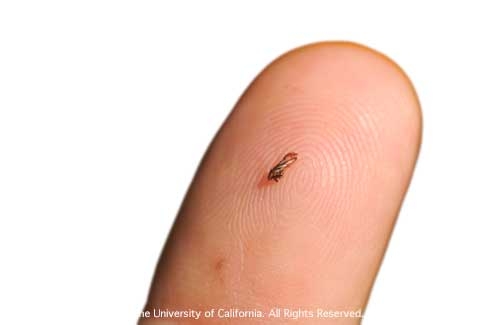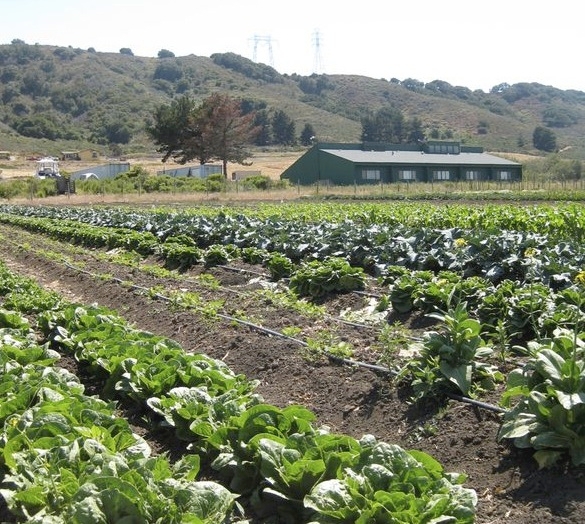
Posts Tagged: san luis obispo
Asian Citrus Psyllid Found in San Luis Obispo County
San Luis Obispo County has seen more than 20 detections of Asian citrus psyllid (ACP) since...

Lemons on a tree. (Credit: Pixabay.com)

Actual size of Asian citrus psyllid. (Credit: B. Grafton-Cardwell)
Citizens Concerned about Sudden Oak Death in San Luis Obispo County
From the ANR News Blog Central Coast residents, officials, ranchers and representatives of...
San Luis Obispo County local food roots are strong, can support growth

A new report assessing San Luis Obispo County's food system links the vitality of the county's agriculture with the health of its residents and its food businesses.
Conducted by the UC Sustainable Agriculture Research and Education Program (UC SAREP) and Central Coast Grown (CCG), the San Luis Obispo County Food System Assessment examines the relationships between agriculture, regional environmental quality, human health and local livelihoods.
“We found that the county food system in San Luis Obispo is thriving with increased agricultural sales and school districts beginning to participate in garden-based education,” says Jenna Smith, executive director of Central Coast Grown. “But there are many opportunities for improvement. With excitement building around local food and improved nutrition, it's vital for a county to see an honest accounting of where it stands in those arenas.”
In 2007, farmers in San Luis Obispo County sold agricultural products valued at $4.3 million directly to consumers, an increase from previous years. The report suggests that continued promotion of local and direct marketing of food can assist all producers, including new farmers, in entering the marketplace and bolstering the local food system overall.
Those markets will be especially important as the number of farmers in the county grows. In 2007, there were 850 more agricultural producers than 10 years prior. But the majority of farms in 2007 reported gross sales of under $250,000 per year, with nearly half of all farms in the county reporting less than $5,000 in annual sales.
“Unfortunately, we have little information available to define who these small-scale farmers are, what they are growing, how they impact local employment, and how they might interact with the local food system,” said Mary Bianchi, director of UC Cooperative Extension in San Luis Obispo County, who advised on the report. “We need a better understanding of what these farmers produce, and how they can better participate in the local food economy.”

In a parallel survey conducted by Central Coast Grown, they asked farmers and restaurant owners about the challenges to selling and buying locally.
“Our survey reinforced the findings of the SLO Food System Assessment,” says CCG director Smith. “Both farmers and restaurant owners reported a need and value for localized distribution channels.”
The report also addresses access to healthy food as a component of the county's food system. Participation in food assistance programs like CalFresh and food distributed by food banks in San Luis Obispo County have both increased over the last decade, though overall food insecurity in the county has improved marginally.
While increases in food distribution may mean those outlets are accessing more people, it also means more people are in need of the assistance.
Beyond continued support from government food programs, the report recommends ways that increasing food access for the public and improving markets for local producers can reinforce one another. Food-focused community development strategies such as mobile markets, community farms, and farm-to-school bring agriculture into neighborhoods and schools and help close the gap between producers and consumers.

San Luis Obispo County also faces water quality and water quantity challenges that are echoed throughout the state. Nitrate contamination from both urban and agricultural sources affects local lakes, rivers and streams. Groundwater and coastal stream resources both present significant challenges for agriculture and rural communities dependent on them for drinking water.
“Accounting for those concerns within the context of the entire food system may bring a broader scope to the discussion along with the potential to leverage the efforts of the many groups already working on water resources issues,” Bianchi said.
The Food System Assessment was conducted in partnership with the San Luis Obispo County Food System Coalition. Coalition meetings are held quarterly to discuss local food system issues and are open to the community. The report was funded by the California Department of Food and Agriculture which also supports Central Coast Grown's upcoming release of a Public Land Survey that identifies underutilized agriculturally viable land county-wide.
The report is available on the UC SAREP and Central Coast Grown websites.
UC, CSU team up on agricultural, environmental research projects

Leadership of California’s higher education systems made the funding available to jointly address issues in agriculture, natural resources and human sciences. Project criteria include collaborative research, teaching, or course development; development of student internship opportunities; and workshops, conferences, and symposia. Eight projects totaling more than $79,500 were selected from 30 proposals submitted.
“These research projects will help leverage limited resources to produce quick results on important issues in California,” said Neal Van Alfen, dean of the College of Agricultural and Environmental Sciences at UC Davis. “They are also building stronger connections among researchers throughout the state and providing hands-on learning opportunities for students.”
Researchers involved in this year’s projects are from UC Davis, UC Berkeley and California State University campuses at Chico, Fresno, Humboldt, Pomona, Sonoma, San Marcos and San Luis Obispo. The awarded projects, with principal investigators, are listed below:
- “Estimating residential water demand functions in urban California regions” — Economists from UC Berkeley and Cal Poly San Luis Obispo will estimate residential water demand of municipalities and water companies that serve 19 million people in the Bay Area and Southern California. (Maximilian Auffhammer, Stephen Hamilton)
- “Reintroduced mammals and plant invaders as key drivers of ecosystem processes in coastal and interior grasslands” — Researchers from Sonoma State University and UC Davis will study how reintroducing tule elk and reducing invasive Harding grass affects the availability of soil nutrients and the composition of plant communities. (Caroline Christian, J. Hall Cushman, Valerie Eviner)
- “Genetics of plant defense responses to pesticides and spider mites on grapes” — Scientists from UC Davis and Cal Poly San Luis Obispo will conduct laboratory, greenhouse and field studies to learn more about factors affecting grapevine response to spider mites, including cultivar resistance, drought impact and pesticide exposure. (Michael Costello, Richard Karban, Andrew Walker, Jeffrey Wong)
- “Defining the functions of polyphenol oxidase in walnut” — Through genetic analysis, researchers at CSU San Marcos and UC Davis seek to learn more about an enzyme involved in the postharvest browning of cut or bruised fruit. (Matthew Escobar, Monica Britton, Abhaya Dandekar)
- “Modeling the costs of hazardous fuel reduction thinning treatments and removal of woody biomass for energy” — Researchers from Humboldt State University, UC Davis, and the U.S. Forest Service will develop a model to estimate the costs of removing hazardous wildland fuels with different equipment and systems over a wide range of forest stand, site and road conditions. (Han-Sup Han, Bruce Hartsough)
- “Restoration of pollinator communities and pollination function in riparian habitats” — Researchers from California State University, Chico, and UC Davis will characterize native pollinator communities at restored riparian habitats within the Central Valley and test whether successful restoration of pollinator communities also leads to restoration of pollination. (Christopher Ivey, Neal Williams)
- “Estimating alfalfa’s impact on regional nitrogen budgets and nitrate leaching losses in the Central Valley of California” — Researchers from California State University, Fresno, and UC Davis will collect alfalfa and non-legume plants from irrigated fields and also identify San Joaquin Valley farm sites for a multi-year study of alfalfa’s impact on regional nitrogen budgets, groundwater nitrate leaching, and nitrogen requirements of rotation crops. (Bruce Roberts, Stuart Pettygrove, Daniel Putnam)
- “Community and ecosystem response to elevated nitrogen in managed grassland ecosystems” — Restoration ecologists from Cal Poly Pomona and UC Berkeley will investigate how elevated nitrogen levels affect competition among native and exotic plant species with regard to fuel characteristics at UC’s South Coast Research and Extension Center. (Erin Questad, Katharine Suding)
Reports on project outcomes are expected in December 2012.
